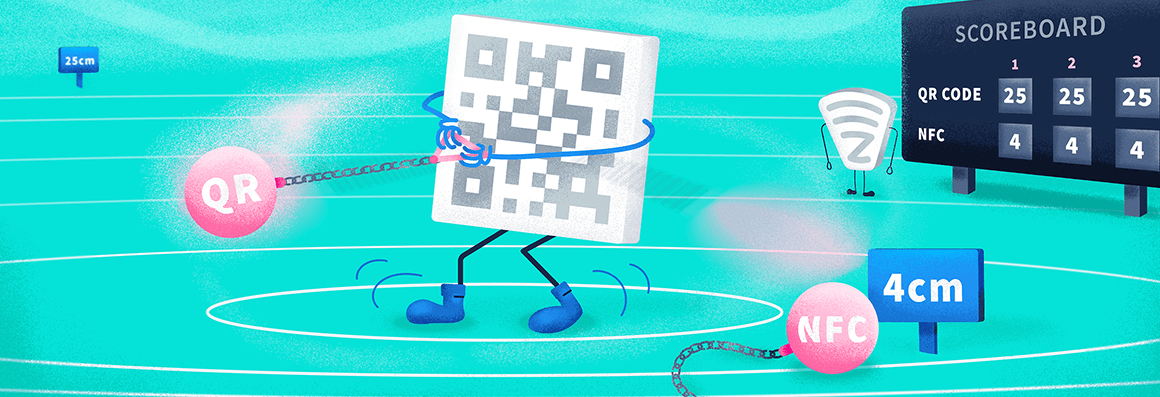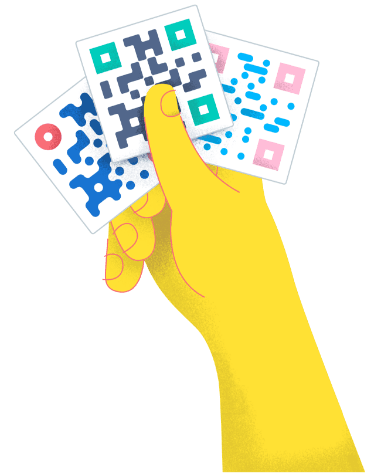- Best Practices ●
- COVID-19 ●
- Industry Trends ●
- Partners ●
- Product ●
NFC vs. QR Code: Why QR Codes Are the Clear Winner
While NFC technology is useful for digital file sharing and data transfers, it still requires physical contact and has a very short radius for use. Today, people expect convenience in shopping, technology, and their everyday lives, which makes simple data-sharing systems more important than ever.
This is precisely why Quick Response (QR) Codes are a much more suitable tool for contactless payments and data transfers. QR Codes are more secure than NFC-enabled technology and can be scanned from near and far—with absolutely no physical contact.
What is NFC?
Near Field Communication (NFC) is an RFID electronic method for smartphones or other devices to interact with each other within close proximity.
NFC works based on a tag (a small NFC chip) and has a radius of about 4 cm (1.5 in). It creates a wireless connection that doesn’t need mobile internet to function and is also free to use as long as your offline device or card has the NFC tag installed.
How is NFC used?
NFC technology entered the market back in 2008, and many people have been using it for a while without realizing it. If you’re wondering how contactless payments with credit and debit cards work, that’s NFC technology.
More recently, NFC combined with Google and Apple Pay to make wallets entirely digital for cashless and mobile payments.
In addition to contactless payments, other advantages of NFC include:
- Sending a phone number
- Sending pictures
- Sending documents
- Sending directions with Google Maps
- Starting an app on another device
- Connecting with other NFC tags
Top use cases for NFC
Here are some of the top use cases for NFC in modern technology:
- Bluetooth pairing
- Digital business cards
- Contactless payments
- Access control system (hotel room keys, event passes, etc.)
- Asset tracking.
What is a QR Code?
QR Codes were originally invented to improve on the technology of barcodes for use in product inventory management.
The technology became public in 1994 and has made massive waves for inventory management and digital information transfer across just about every industry imaginable.
A QR Code on a billboard is scannable from a long distance
A QR Code’s innovative functionality is due to its square shape. While you can only scan barcodes horizontally and with a special scanner, QR Codes are scannable horizontally and vertically. Unlike traditional barcodes, most modern smartphones have QR Code readers built in, making them accessible for anyone with a smartphone.
Their ease of use, comprehensive range of flexibility, large data storage capacity, and damage resistance are what have made them so popular and multifunctional on a global scale.
How are QR Codes used?
QR Codes have a much wider range of use than both barcodes and NFC. To give an idea of just how much they can do, here are some examples of the types of QR Code applications commonly used today:
- Contactless and mobile payments during checkout
- Bitcoin payments
- Enabling WiFi access
- Sharing PDFs
- Sharing app store links
- Creating digital business cards and business pages
- Sharing social media links
- Sharing video, image, and sound files
- Connecting users with website links
- Automatic event registration and ticketing
- Collecting feedback and ratings
- Sending text messages, plain text, and emails
- Creating digital coupons
- Location sharing with Google Maps
People can use QR Codes on any size of print materials and on digital marketing platforms to elevate user experience.
Top use cases for QR Codes
Here are some of the most common uses of QR codes.
- Bus stop and train station ads
- Business cards
- Customer surveys
- Coupons
- Giveaways
- Promotional items.
4 disadvantages of NFC (and why QR Codes are better)
While NFC is useful in some circumstances, the benefits of using QR Codes far outweigh the advantages of NFC technology. QR Codes are more secure, convenient, accessible, and have a wide range of use cases across every industry.
And most importantly, QR Codes don’t require any physical contact and have no distance limitations—unlike the NFC.
1. Limited mobile payments
Although some newer smartphone models automatically come with NFC tags, not all of them do. If your phone doesn’t have one, it can be tough to add an NFC tag to it. If you’d like to use NFC to make mobile payments, you’d be better off using wearables like a smartwatch.
You can use QR Codes for mobile payments without physical contact or needing a chip like NFC
Why QR Code technology is better: In reality, dropping a few hundred dollars on a new wearable tech is not the most convenient option. QR Codes make this process 100 times easier because you don’t need any additional equipment to pay with them.
Wallets like Google Pay (Android phones) and Apple Pay (iPhones) automatically enable mobile payment via digital wallets with QR Codes. In both cases, all you need is to have the relevant wallet app installed and scan a vendor’s QR Code that accepts that form of payment—and this with absolutely zero physical contact.
For example, if you’ve forgotten your wallet during a grocery run, you can pay with your mobile wallet. Some retail outlets will let you scan a QR Code to initiate a mobile payment.
2. Short distances only
NFC technology has a radius of a mere 4 cm (1.5 in). Furthermore, NFC tags can be in different areas of different phones or devices, so most of the time, you need the devices to have direct contact for the information transfer to work. In a post-pandemic environment, rubbing contaminated surfaces together and spreading bacteria renders NFC technology less appealing than contactless options.
QR Code technology is scannable from far away and doesn’t require physical contact
Why QR Code technology is better: Instead of rubbing your smartphone with public devices and potentially spreading viruses, opt for a contactless technology like QR Codes. QR Code scanning takes place from a distance, even extreme distances. You can scale up QR Codes as large as you need, even on billboard ads or larger.
The only requirements are that the QR Code is at least 2 x 2 cm (0.8 x 0.8 in) and is a high-quality image—otherwise, people and QR Code scanners could have trouble reading it.
For example, people can scan QR Codes on far-away bus station ads before heading to work. QR Codes are extremely versatile when it comes to scannability, unlike NFC tags.
3. Device compatibility issues
NFC is in no way a universal technology. NFC users often encounter problems with sharing files. This can happen both due to the users having different types of smartphones and due to the file format being incompatible with the other user’s device. When phones’ operating systems update, it can negatively affect NFC functionality.
Overall, the whole NFC system isn’t quite prepared for universal and convenient digital information transfer. It just creates confusion and incompatibility.
NFC file transfers can be incompatible across different devices
Why QR Code technology is better: Even though QR Codes predate NFC, the concept of universal use was already an essential part of their design. You don’t need a special scanner to scan QR Codes.
All smartphones can scan QR Codes (whether automatically through the camera app or through a third-party app), and the process for scanning them to access content is more or less the same across all mobile devices.
QR Codes have always been and always will be universal, convenient, and easy for anyone with a smartphone because you simply scan the QR Code and view its content—whether your phone uses Android, iPhone, or another operating system.
This also means you can quickly set up QR Codes for your customers. Professional engineers usually have to install NFC tags. Meanwhile, anyone can create a QR Code and tailor it to every major device.
4. Major security flaws
One of the most prominent disadvantages of NFC is the general lack of security measures related to it. There are a variety of risks:
- Eavesdropping: This happens when a criminal “listens in” on an NFC translation to steal private information.
- Data corruption or manipulation: The data transferred during an NFC transaction can be corrupted and manipulated so the receiver can’t use it.
- Interception attacks: This occurs when a hacker reroutes an NFC data transfer to a device other than the intended one.
NFC comes with serious security risks from criminals that manipulate and steal personal data
Why QR Code technology is better: QR Codes are much more secure than NFC. There is no risk of eavesdropping, data manipulation, or interception attacks because only the person scanning the QR Code has control over how they view the content.
For example, in the healthcare industry, QR Codes can be encrypted and linked to patient data. The encryption reduces the risk of unauthorized access and tampering. However, medical identification systems that use NFC technology may face security vulnerabilities like data interception or patient record tampering.
Furthermore, our URL shorteners make it so only the account owner can change a QR Code’s link, so there is no chance of users being redirected to harmful sites. We take QR Code security extremely seriously and have also developed methods for making QR Codes authentic and trustworthy.
Start your journey with QR Codes today
Ultimately, both NFC and QR technology have their uses. Both are spectacular forms of new technology that allow contactless payments and seamless data sharing.
However, QR Codes are superior to NFC-enabled devices because of their ease of use, security, and flexibility.
Ready to create secure QR Codes with unmatched versatility? Get started with QR Code Generator PRO today.






 Add custom colors, logos and frames.
Add custom colors, logos and frames.

